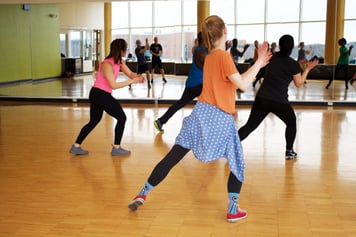We all know that warming up before a workout is a good idea whether we actually do it or not. But designing a warm-up to start your workout with safety and efficiency may be confusing. In this blog, we’ll review the three main phases of a warm-up and why they’re important. We’ll also share a few options for designing your own warm-up routine.
Inhibition.
Before you begin a workout, be sure to address any overactive muscle groups through the process of inhibition. Inhibition is the calming or restricting of a particular muscle group. Calming these overactive muscles can help to bring healthy posture. This reduces the chance of injury. It also promotes healthier movement and range of motion. You can identify overactive muscle groups by noting what feels tight or knotted. A personal trainer can also help you identify overactive areas across your body.
When it comes to designing the inhibition phase, there are a few approaches. Self-Myofascial Release (SMR) refers to the technique of applying pressure to a knotted or overactive area to signal the muscle to relax. This can be accomplished with a foam roller or lacrosse ball, or even your hand if you’re short on equipment. When performing SMR, apply pressure over the muscle group until you find a trigger point. A trigger point is a feel-good kind of hurt or tender point. Once found, apply pressure to that point for 30-90 seconds to signal a release. Helpful hint: try to find one knot in each muscle group that you plan to target.
Activation.
The second, and probably least used, part of a great warm-up is the process of activation. Activation is waking up a certain muscle group that will be a main mover during your workout. This can increase blood flow to the active muscle tissue. It also increases your body’s ability to use oxygen which is crucial to muscle contraction. This process also enhances our “mind-body connection.” This is the link between our central nervous system and the muscles we’re trying to fire at any given time.
When designing the activation phase of your routine, be sure to target the muscle groups that you plan to use during your workout. For example, if it’s leg day, target the glutes since they’re a prime mover in most leg routines. You can do this through glute bridges and other specific movements. Be sure that you’re concentrating on contracting that muscle during the movement for the greatest effect.
Raising Your Temp.
The last component of a great warm-up routine is to raise your body’s core temperature. This can increase the rate that your muscles can contract, enhance your body’s ability to use stored energy and allow for more stretchiness of soft tissue. All of these contribute to the faster and safer performance of a given muscle group you’re targeting.
When you’re designing this portion of your warm-up, it’s important to use full-body movements whenever possible. When more muscle groups are used more energy is needed. This means more energy is burned which creates heat for raising your body’s temperature. Try movements like jumping jacks, burpees, mountain climbers or even go for a brief run. The duration of this phase can vary but make sure you get at least of 5 minutes, but no more than 15 minutes.
.png?width=1650&height=1275&name=website%20images%20(30).png)
Table of contents



